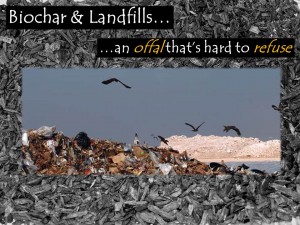Recently I saw an interesting article about the potential of biochar to reduce the amount of waste filling up landfills. The focus was on how waste generators or haulers could reduce tipping costs which are poised to increase as old landfills close and new ones are often much further afield as few people want them in their backyard (hello NIMBY!). Cost reduction is one of the biggest motivators for companies and individuals to become more sustainable. Who doesn’t want to save money, right? And in this situation the business case for biochar use at landfills seems almost ridiculously easy to make for landfill operators. I won’t waste another moment shedding light on this great closed loop biochar model. Here’s my thinking:
Let’s say the landfill operator invests in some state-of-the-art pyrolysis equipment (one example here which actually generates electricity) so that they can continue to accept yard waste (which is being outlawed in a number of states due to the scarcity of local landfill space). Not only can the yard waste tipping fees keep adding to their coffers but it could be converted into biochar which could be used as a very effective ‘daily cover’. The federal government requires landfills to apply a 6” layer of daily cover which is meant to reduce pathogens, fires, flyaway garbage and lest we not forget the lovely aroma that often wafts away from overgrown rubbish piles. Landfills use a variety of different materials for daily cover depending on availability, cost and local regulations. Substituting biochar as a daily cover could be advantageous for all sorts of reasons. The University of Illinois has been studying the ability of biochar in landfills to suppress methane with promising results so far.
Other researchers are studying the ability to use biochar to clean landfill leachate in microbial fuel cells. Early results show activated carbon to be more efficient, but I suspect there are ways to tweak the biochar production parameters or the biochar could be magnetized to improve the filtration capabilities of biochar. This could be a huge savings as some landfills end up having to ship leachate off to a waste water treatment facility if they cannot process it on-site.
Perhaps the most interesting one for those that live in the vicinity of landfills is the ability of biochar to suppress “l’eau du dump”, that unforgettable smell that permeates neighboring air. Using biochar as a cover material would likely substantially reduce the amount of sprayers that some landfills use to mask the nasty odors (what is in that stuff one wonders?).
At the end of the landfill’s active duty, biochar could also help with re-vegetation, something that can be problematic or at least expensive in some areas. Last but definitely not least in the benefits equation, is all that carbon that landfills will be able to sequester. While it may not be worth money yet in the US, the day when biochar is a viable carbon offset is coming!


